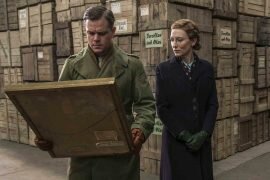For his third feature, Dan Gilroy ventures into the world of commercial contemporary art, this time sans a zeroed in character study. Instead he’s mustered an ensemble, headed by a trio. First up, but not necessarily foremost, is Jake Gyllenhaal as Morf Vandewalt, a critic who hides his lack of integrity and insight behind faux eloquence. He shares a mutually advantageous understanding with art dealer Rhedora Haze, played by Rene Russo. A performance that is on a gradient relative to the caricatures that surround her. Partly because she’s the only one with a brief but clearly delineated backstory. In which she was once in a punk band, but now she’s only in it for the money and so transplants a hard edgeness previously furnished under an ethos of some shape or form, into a more cynical vessel. So that she can survive the roost she rules; where art, and everything else, doesn’t have any value save for digits that follow the dollar sign. Something that Zawa Ashton as Josephina, an agent and Haze’s put-upon underling, acts upon when she steals the paintings of her recently deceased neighbour. A man with a shadowy past that is both the subject and impetus of his equally warped work. Their ‘authenticity’ sends the value of the canvases skyrocketing but also bleeds a supernatural power that wreaks havoc on everyone out to profit from it.
As a subject of satire, the art world makes for, and is shaped into, a titanic moving target. One that is rife with gluttony, and excess to boot, and yet it appears brittle. It’s where (self) proclaimed aesthetes and visionaries roam, herding chatter that just adds to the vacuity. Gilroy communicates this with a digital palette that’s nice and dry, a morass of cold, urban spaces and a deck of caricatures, stacked by hams. Gyllenhaal is nearly the king of this ilk, as a peacock sporting a mannered fey accent and a suspect vocabulary. He’s introduced waltzing around a gallery with a near perpetually curled wrist, delivering pans, superlatives and a pick n mix of critical clichés, that whip between being kind of funny and limp. The film’s attempts at satire in general tend to suit the latter judgment, for it rarely probes beyond stating and repeating the industry’s obvious failings. And otherwise builds a pessimistic yet tepid worldview which encompasses a dismissive attitude towards a post-Duchampian strain of the plastic arts and a suspicion of not only the business of valuation but the concept and practice on the whole.
Whether its satire is incisive or not is nearly beside the point. Since most of its fun is derived from all these caricatures colliding in a series of bites and bite backs. Deliver through the medium of platitudes processed by the bile churning behind all those Pan Am smiles or through more pointed tear-downs. The impression given is of a cycle of backstabbing, propagated tit for tat by either
enthuastical or indentured participants. Either way they are all out work or network themselves, up the ladder, and their enemies into oblivion. Meanwhile there’s the horror plot, which starts picking people off in set pieces where Gilroy’s chops are few and far between. For the kills are never sudden but instead are worked towards, as end points of little filmic pressure cookers. But the tension required is undercut by sloppy construction and despite the array of materials that this milieu has to offer, there is a pronounced lack of imagination in both the killing blows and the viscera on display, save for a few tentatively nasty moments. Neither does the verbiage keep up. Instead the best lines are kept, for the most part, in the first half, leaving the rest of the film to bide its time and fatally so. For as it moves towards a full, knives out ending, the hope would be that the tools at Gilroy’s disposal would be at their sharpest. Instead they are disappointedly dulled.



